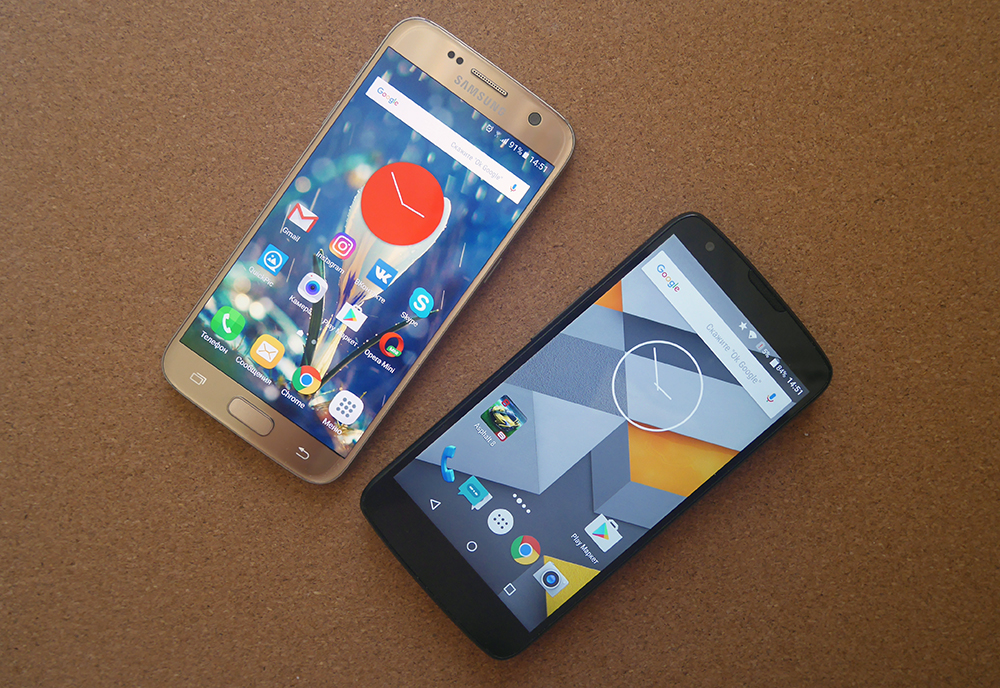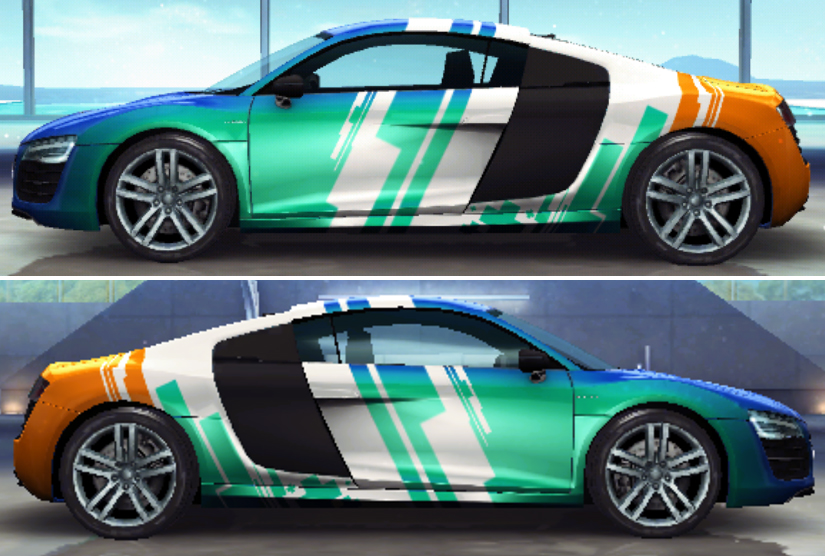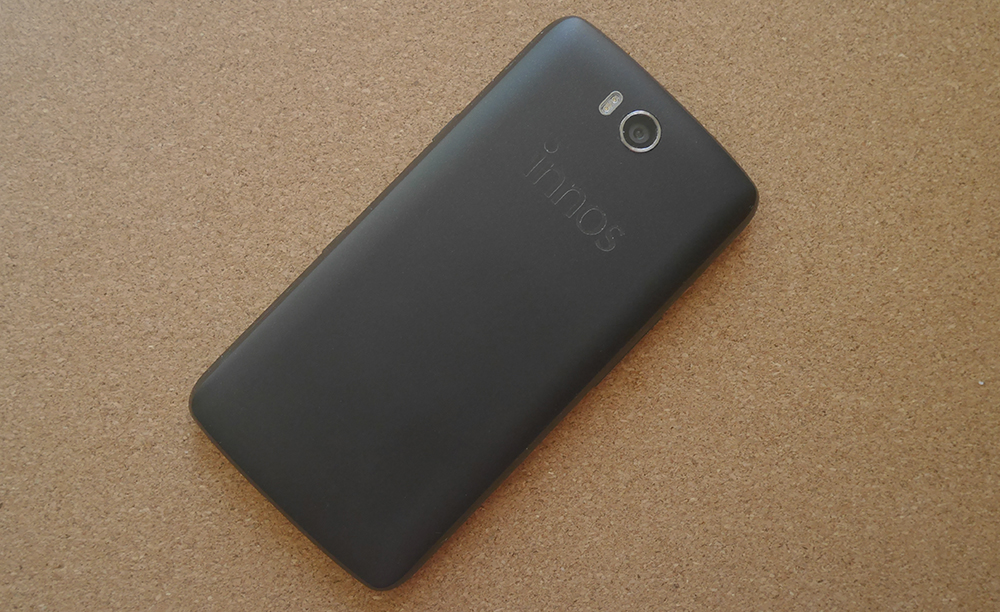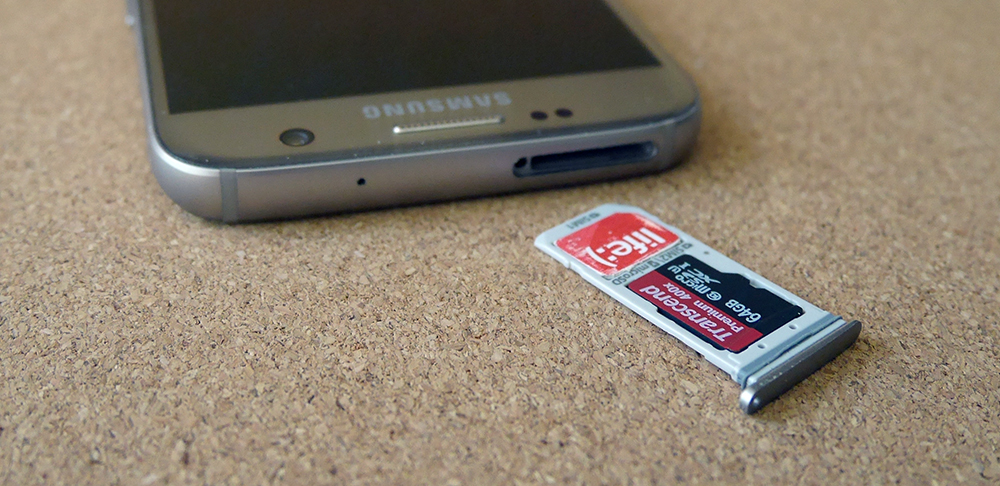Operating experience innos D6000 vs. Samsung Galaxy S7: Convenience in the details
Hello! The following post is something like a review of the format In Use. This means that I will not talk in every detail about each button, cog and icon (this has already been done for a long time), but I’ll tell you about the operational features of the innos D6000. And at the same time I will compare it in this section with the flagship Samsung Galaxy S7, which I also use. Immediately I consider it necessary to emphasize: you should not take this text as a comparative review of the two aforesaid apparatuses. They are very different, and the first is 15 990 rubles, and the second is 49 990 rubles. It is clear that in the Korean flagship a lot is implemented at a much higher level, and there is no point in arguing with that. However, some of the points that I discovered for almost half a year with the innos D6000, make it necessary to consider the latter to be at least (or even more!) A thoughtful device.

The moment number 1: fall . Much to my regret, once I dropped innos D6000. Well so, from a height of a meter. And on the asphalt. The device fell on one of the upper corners of the "face" down. Fell - and ... nothing happened to the screen. The reason for such luck - a small, height in fractions of a millimeter, the frame around the perimeter of the front panel. A couple of years ago, such a framework was an attribute of almost all smartphones (for example, it also exists in the Galaxy S5), and now manufacturers have taken a great interest in 2.5D glass and have refused such “protection elements”.

')
In the same Galaxy S7, a slightly curved glass is used, and if this device were in the innos D6000, I probably would have to fork out to replace the screen. This is what I mean: beauty is beauty (2.5D-glass and really looks great), but personally I am for reliability. And innos D6000 provides it.
The moment number 2: graphics in games . It would seem that the more powerful the chipset is, the more (in theory) this or that smartphone displays the 3D games better. In practice, everything is somewhat different, at least when comparing the innos D6000 and the Samsung Galaxy S7. The first uses a Qualcomm Snapdragon 615 viewer, the second uses the newest Samsung Exynos 8890 with a much more powerful graphics core. However, in my favorite toy - Asphalt 8 - the details of the machines are higher in the case of innos D6000. Just look at the screenshots below:

Above - screenshot with innos D6000, below - with Samsung Galaxy S7
It is clear that sooner or later Gameloft will release an update that will raise the quality of graphics on the Samsung Galaxy S7 to the level of innos D6000 or even higher. It cannot be otherwise. Nevertheless, this moment is quite indicative: Qualcomm chipsets with their Adreno graphics are the most popular solutions for Android smartphones designed for rich countries with a solvent population (USA, Europe, Japan, etc.). So, game developers optimize their titles primarily for Qualcomm solutions, and not for Samsung, and certainly not for MediaTek, which are used in most smartphones of young Chinese brands.
The moment number 3: ergonomics in games . I was not particularly upset when I saw that the Galaxy S7 still showed a lower level of graphics in games. Why? It's just not convenient to play on ultra-thin smartphones with fairly “sharp” metal frames around the perimeter. That is why I hardly made a couple of races on the Galaxy S7 in Asphalt 8 - and I realized that I wouldn’t play more on it. Never.

For games "chubby" devices are better suited than ultrathin
Meanwhile, “hanging out” with innos D6000 in the above mentioned toy for a couple of hours or five is not a problem at all. Because, thanks to a thickness of 12 mm, the device almost perfectly fits in the hands. Moreover, during the game you do not touch the touch keys under the screen, because they are not in innos D6000. (Their grazing on other devices sometimes leads to crash or, for example, loss of progress.) The Galaxy S7, however, has a special setting to deactivate them in the game mode, but in the case of a lot of other smartphones - for example, Galaxy S5 and Lenovo K900 - I lost progress more than once precisely because I accidentally pressed a finger on these buttons.
The moment number 4: the durability of the case . Someone can blame innos D6000 for excessive obesity: they say, 12 mm is a lot. I will say this: first, in practice, the device does not seem thick. Yes, it is thicker than the average modern smartphone, but not much. Secondly, the materials used make it possible to exploit the innos D6000 in the tail and in the mane, without fear of spoiling the exterior of the device. So, the back panel is made of polycarbonate - and after three months of wearing in the pocket of jeans, the smart looks like new.

After six months of operation, the back cover of the innos D6000 is in a state of new
Samsung Galaxy S7 is made of glass, that is, it is used both in front and behind. On the third day after the purchase, a pair of very noticeable scratches formed on the back part - and this despite the fact that the device never fell and didn’t rush into your pocket at all. Yes, I am aware that this is Gorilla Glass 4 (the latest generation), and that many owners of the "seven" call it almost unkillable. But I did it like this. In order to avoid the appearance of new scratches on an expensive device, the Galaxy S7 had to be enclosed in a branded case. And as a result, its thickness became exactly the same as that of the innos D6000, which, due to its high durability, does not need covers.

In the original cover of the book, the thickness of the Samsung Galaxy S7 is the same as that of the innos D6000. At the same time, it is still not convenient to play the “Korean”: if you flip the cover flip over the back panel, the device cannot be firmly held in your hands
The moment number 5: the design of card slots . Samsung for some reason (and much to my regret) went in the wake of a strange Chinese fashion: there are two slots for SIM-cards in the Galaxy S7, but you can insert a USB flash drive in one of them. Is it convenient? It's horrible! Yes, you can make a so-called “sandwich” by cutting out a piece from nanoSIM and pasting this very piece to a fingered (!) MicroSD, and then try to insert it all into the device ... Someone succeeds, and the smartphone works simultaneously with two SIM cards and a USB flash drive . And someone as a result remains without a SIM card, without a memory card, or even without a smartphone, which fails due to the above actions.

Either two sims, or simka + flash drive. The logic of the developers of the device for 50 thousand rubles is not clear to me personally
With the innos D6000, everything is much more convenient: you can insert two SIM cards (and at least microSIM, even nanoSIM - the nest design allows) and a separate memory card. I hope that sooner or later, smartphone makers will forget this stupid trick with slots overlapping and return to what we see in the innos model. And today, the combined slots are observed in more than half of the "Chinese". And also in some "Koreans" ...

innos D6000: three full slots
The moment number 6: interface connector . Almost all the top flagships of 2016 we see USB Type-C - the one into which you can insert the cable by any side (which is very convenient). And only for some reason Samsung remained true to MicroUSB, which managed to get rather annoyed precisely because in the dark you need three (five, ten ...) times to try to plug in the cord in order to finally select its correct position.
Meanwhile, in the innos D6000 we see a symmetrical USB Type-C. Today it is rarely found in devices priced at up to 20 thousand rubles, and this model, we recall, costs 15 990 rubles.

The moment number 7 (the most important and basic): autonomous work .
The innos D6000 has two batteries: a built-in 2 480 and a removable 3 520 mAh. Total 6 000 mAh. The video in DVD-quality device can “twist” up to 24 hours, in HD-quality - up to 14. Samsung Galaxy S7 lives in the same modes for about 14 and 8 hours, respectively (with a battery capacity of 3,000 mAh). The results for the device with a QHD-screen and a chipset, which provides 120 thousand points in AnTuTu, are in fact excellent. And nevertheless, on business trips - and they are usually accompanied by my daily travel by train - I take innos D6000 with me. Because he still has no equal in autonomous work. And if you buy another couple of removable batteries (990 rubles apiece at innos.com/ru ), then you can not drag along with it.

innos D6000 works with the extracted external battery, in addition, you can buy as many as you need such batteries and increase the capacity almost unlimited
In the mode of daily operation (without video, but with the Internet, social networks, photos, and so on), the Samsung Galaxy S7 I have up to two days, and innos D6000 - up to four.
The moment number 8 (bonus): quality oleophobic coating . In Asphalt 8 I started playing in 2010 on the Samsung Wave - and after two months the screen went stained. This erased the oleophobic coating in those places where the fingers most often touch the screen as a result. The same spots appeared after three months of playing on the screen of the Motorola Droid Turbo, after the same three months on the screen of the Samsung Galaxy S4. But on innos D6000 I have been playing for about six months, and the oleophobic coating has not faded at all. There are no blemishes. Here you have an inexpensive "Chinese"!
And I called this bonus point because I cannot compare the innos D6000 with the Samsung Galaxy S7 - as I said above, I can't play the last one.
Total Once again: I don’t want to say that the Samsung Galaxy S7 is a bad smartphone, and the innos D6000 is a good one. They are both good and worth their money. Just to get maximum opportunities in my particular case, they have to be combined. Games and business trips are part of the innos D6000, photography and image tasks are the Galaxy S7. At the same time, to be honest, I don’t quite understand why in the case of the innos D6000, the developers thought out some points (interface connector, slot design) and added a lot of nice little things that drastically increased operating convenience, but the Korean wizards did not think about these important things at all. After all, their offspring is more than three times more expensive than innos D6000.

The moment number 1: fall . Much to my regret, once I dropped innos D6000. Well so, from a height of a meter. And on the asphalt. The device fell on one of the upper corners of the "face" down. Fell - and ... nothing happened to the screen. The reason for such luck - a small, height in fractions of a millimeter, the frame around the perimeter of the front panel. A couple of years ago, such a framework was an attribute of almost all smartphones (for example, it also exists in the Galaxy S5), and now manufacturers have taken a great interest in 2.5D glass and have refused such “protection elements”.

')
In the same Galaxy S7, a slightly curved glass is used, and if this device were in the innos D6000, I probably would have to fork out to replace the screen. This is what I mean: beauty is beauty (2.5D-glass and really looks great), but personally I am for reliability. And innos D6000 provides it.
The moment number 2: graphics in games . It would seem that the more powerful the chipset is, the more (in theory) this or that smartphone displays the 3D games better. In practice, everything is somewhat different, at least when comparing the innos D6000 and the Samsung Galaxy S7. The first uses a Qualcomm Snapdragon 615 viewer, the second uses the newest Samsung Exynos 8890 with a much more powerful graphics core. However, in my favorite toy - Asphalt 8 - the details of the machines are higher in the case of innos D6000. Just look at the screenshots below:

Above - screenshot with innos D6000, below - with Samsung Galaxy S7
It is clear that sooner or later Gameloft will release an update that will raise the quality of graphics on the Samsung Galaxy S7 to the level of innos D6000 or even higher. It cannot be otherwise. Nevertheless, this moment is quite indicative: Qualcomm chipsets with their Adreno graphics are the most popular solutions for Android smartphones designed for rich countries with a solvent population (USA, Europe, Japan, etc.). So, game developers optimize their titles primarily for Qualcomm solutions, and not for Samsung, and certainly not for MediaTek, which are used in most smartphones of young Chinese brands.
The moment number 3: ergonomics in games . I was not particularly upset when I saw that the Galaxy S7 still showed a lower level of graphics in games. Why? It's just not convenient to play on ultra-thin smartphones with fairly “sharp” metal frames around the perimeter. That is why I hardly made a couple of races on the Galaxy S7 in Asphalt 8 - and I realized that I wouldn’t play more on it. Never.

For games "chubby" devices are better suited than ultrathin
Meanwhile, “hanging out” with innos D6000 in the above mentioned toy for a couple of hours or five is not a problem at all. Because, thanks to a thickness of 12 mm, the device almost perfectly fits in the hands. Moreover, during the game you do not touch the touch keys under the screen, because they are not in innos D6000. (Their grazing on other devices sometimes leads to crash or, for example, loss of progress.) The Galaxy S7, however, has a special setting to deactivate them in the game mode, but in the case of a lot of other smartphones - for example, Galaxy S5 and Lenovo K900 - I lost progress more than once precisely because I accidentally pressed a finger on these buttons.
The moment number 4: the durability of the case . Someone can blame innos D6000 for excessive obesity: they say, 12 mm is a lot. I will say this: first, in practice, the device does not seem thick. Yes, it is thicker than the average modern smartphone, but not much. Secondly, the materials used make it possible to exploit the innos D6000 in the tail and in the mane, without fear of spoiling the exterior of the device. So, the back panel is made of polycarbonate - and after three months of wearing in the pocket of jeans, the smart looks like new.

After six months of operation, the back cover of the innos D6000 is in a state of new
Samsung Galaxy S7 is made of glass, that is, it is used both in front and behind. On the third day after the purchase, a pair of very noticeable scratches formed on the back part - and this despite the fact that the device never fell and didn’t rush into your pocket at all. Yes, I am aware that this is Gorilla Glass 4 (the latest generation), and that many owners of the "seven" call it almost unkillable. But I did it like this. In order to avoid the appearance of new scratches on an expensive device, the Galaxy S7 had to be enclosed in a branded case. And as a result, its thickness became exactly the same as that of the innos D6000, which, due to its high durability, does not need covers.

In the original cover of the book, the thickness of the Samsung Galaxy S7 is the same as that of the innos D6000. At the same time, it is still not convenient to play the “Korean”: if you flip the cover flip over the back panel, the device cannot be firmly held in your hands
The moment number 5: the design of card slots . Samsung for some reason (and much to my regret) went in the wake of a strange Chinese fashion: there are two slots for SIM-cards in the Galaxy S7, but you can insert a USB flash drive in one of them. Is it convenient? It's horrible! Yes, you can make a so-called “sandwich” by cutting out a piece from nanoSIM and pasting this very piece to a fingered (!) MicroSD, and then try to insert it all into the device ... Someone succeeds, and the smartphone works simultaneously with two SIM cards and a USB flash drive . And someone as a result remains without a SIM card, without a memory card, or even without a smartphone, which fails due to the above actions.

Either two sims, or simka + flash drive. The logic of the developers of the device for 50 thousand rubles is not clear to me personally
With the innos D6000, everything is much more convenient: you can insert two SIM cards (and at least microSIM, even nanoSIM - the nest design allows) and a separate memory card. I hope that sooner or later, smartphone makers will forget this stupid trick with slots overlapping and return to what we see in the innos model. And today, the combined slots are observed in more than half of the "Chinese". And also in some "Koreans" ...

innos D6000: three full slots
The moment number 6: interface connector . Almost all the top flagships of 2016 we see USB Type-C - the one into which you can insert the cable by any side (which is very convenient). And only for some reason Samsung remained true to MicroUSB, which managed to get rather annoyed precisely because in the dark you need three (five, ten ...) times to try to plug in the cord in order to finally select its correct position.
Meanwhile, in the innos D6000 we see a symmetrical USB Type-C. Today it is rarely found in devices priced at up to 20 thousand rubles, and this model, we recall, costs 15 990 rubles.

The moment number 7 (the most important and basic): autonomous work .
The innos D6000 has two batteries: a built-in 2 480 and a removable 3 520 mAh. Total 6 000 mAh. The video in DVD-quality device can “twist” up to 24 hours, in HD-quality - up to 14. Samsung Galaxy S7 lives in the same modes for about 14 and 8 hours, respectively (with a battery capacity of 3,000 mAh). The results for the device with a QHD-screen and a chipset, which provides 120 thousand points in AnTuTu, are in fact excellent. And nevertheless, on business trips - and they are usually accompanied by my daily travel by train - I take innos D6000 with me. Because he still has no equal in autonomous work. And if you buy another couple of removable batteries (990 rubles apiece at innos.com/ru ), then you can not drag along with it.

innos D6000 works with the extracted external battery, in addition, you can buy as many as you need such batteries and increase the capacity almost unlimited
In the mode of daily operation (without video, but with the Internet, social networks, photos, and so on), the Samsung Galaxy S7 I have up to two days, and innos D6000 - up to four.
The moment number 8 (bonus): quality oleophobic coating . In Asphalt 8 I started playing in 2010 on the Samsung Wave - and after two months the screen went stained. This erased the oleophobic coating in those places where the fingers most often touch the screen as a result. The same spots appeared after three months of playing on the screen of the Motorola Droid Turbo, after the same three months on the screen of the Samsung Galaxy S4. But on innos D6000 I have been playing for about six months, and the oleophobic coating has not faded at all. There are no blemishes. Here you have an inexpensive "Chinese"!
And I called this bonus point because I cannot compare the innos D6000 with the Samsung Galaxy S7 - as I said above, I can't play the last one.
Total Once again: I don’t want to say that the Samsung Galaxy S7 is a bad smartphone, and the innos D6000 is a good one. They are both good and worth their money. Just to get maximum opportunities in my particular case, they have to be combined. Games and business trips are part of the innos D6000, photography and image tasks are the Galaxy S7. At the same time, to be honest, I don’t quite understand why in the case of the innos D6000, the developers thought out some points (interface connector, slot design) and added a lot of nice little things that drastically increased operating convenience, but the Korean wizards did not think about these important things at all. After all, their offspring is more than three times more expensive than innos D6000.
Source: https://habr.com/ru/post/369483/
All Articles